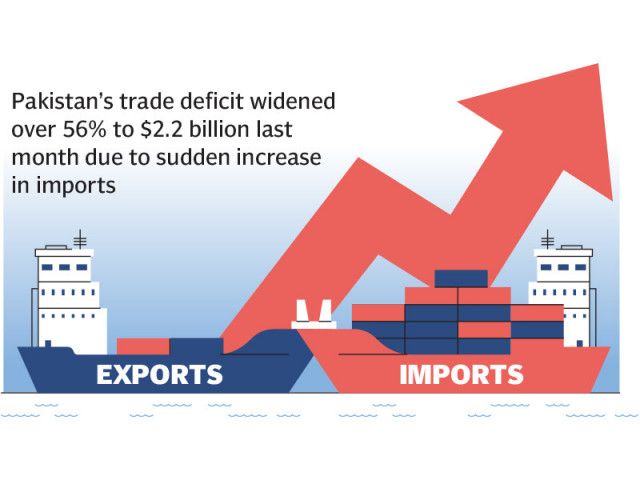Trade deficit expands 56% in March
Import surge widens trade gap that poses challenges to external sector stability

Pakistan’s trade deficit widened over 56% in March 2024 because of a sudden increase in imports, underscoring the challenges being faced by the external sector stability that still hinges on administrative controls.
Pakistan Bureau of Statistics (PBS) said on Monday that the gap between exports and imports increased 56.3% to $2.2 billion in March over a year ago. In absolute terms, there was an increase of $782 million in the trade deficit, a sum that was larger than the last loan tranche of $706 million. PBS said exports amounted to $2.56 billion in March, higher by just $189 million, or 8%, compared to the same month of last year. On the contrary, imports saw a sharp jump to $4.7 billion, higher by $971 million, or 26%.
Pakistan has been keeping a tight control over imports due to the scarcity of foreign exchange reserves. Banks are allowed to open letters of credit (LCs) for imports only to the extent of available liquidity.
The central bank is also taking a major pie from exports and remittances to cushion the country’s foreign currency reserves that remain thin at $8 billion despite the International Monetary Fund (IMF) loan programme.
In spite of enjoying subsidies, nearly zero income tax, relatively cheaper financing and preferential access to European markets, Pakistani exporters have not been able to achieve any meaningful increase in shipments to overseas markets.
Prime Minister Shehbaz Sharif last week announced special perks for the leading exporters and taxpayers. Style Textile was Pakistan’s largest exporter with $522 million worth of exports. There was not even one exporter who could fetch $1 billion annually despite running their businesses under a protectionist regime.
PBS data showed that on a month-on-month basis, trade deficit expanded one-fourth. Exports marginally dipped and stood below $2.6 billion last month compared to February. But imports jumped over 9% to $4.7 billion.
Read Managing trade deficit via three-pronged strategy
Just a few days ago, the finance ministry voiced hope that Pakistan’s exports of goods and services would improve and reach a level around $3.5 billion on the back of favourable demand from major export destinations.
It said that imports of goods and services would touch $5.5 billion in March. Considering these factors as well as other reasons, the finance ministry anticipated that the current account would remain within sustainable limits in the month.
However, owing to the dismal monthly trade statistics, some of the gains made on account of reduction in imports in previous months were lost in March.
During the July-March period of the current fiscal year, the gap between imports and exports came in at $17 billion. The trade deficit was $5.7 billion, or 25%, less than the comparative period of last year. Till February, the reduction in the trade gap was more than 30%.
Imports during the first nine months of the current fiscal year reached nearly $40 billion, down $3.8 billion, or 8.9%, according to the national data collecting agency.
PBS stated that exports picked up during the July-March period and stood at $22.9 billion. There was an addition of only $1.9 billion, nearly 9%, in exports.
During the first eight months of FY24, the current account deficit narrowed to $1 billion. Last month, the finance ministry shared revised projections of the current account deficit, economic growth and external trade with the IMF. Pakistani authorities have projected a further reduction in the current account deficit on the back of a steep decrease in imports and relatively higher exports of certain commodities.
As against the budgeted current account deficit of $6.1 billion, the federal authorities told the IMF that it might fall below $2.5 billion in the ongoing fiscal year.
The finance ministry also sees a further contraction in trade deficit and puts it below $22 billion for the entire fiscal year. It has further lowered import estimates to a little above $52 billion as against the budgetary target of $58 billion. Export forecast has been maintained at $30.5 billion.
Published in The Express Tribune, April 2nd, 2024.
Like Business on Facebook, follow @TribuneBiz on Twitter to stay informed and join in the conversation.



















COMMENTS
Comments are moderated and generally will be posted if they are on-topic and not abusive.
For more information, please see our Comments FAQ